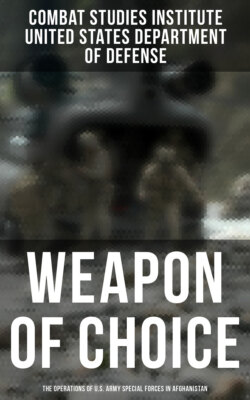Читать книгу Weapon of Choice: The Operations of U.S. Army Special Forces in Afghanistan - Combat Studies Institute - Страница 18
На сайте Литреса книга снята с продажи.
Of Vital Importance: PSYOP
ОглавлениеIn 1951, Secretary of the Army Frank Pace wrote, “The psychological warfare program” is of “vital importance to national security and defense.” The level of importance was quite evident as the 4th Psychological Operations Group (POG) began planning for PSYOP missions in Afghanistan shortly after the 9/11 terrorist attacks. The group was to provide operationaland tactical-level PSYOP to undermine the terrorists and to separate them from their support systems. While the 4th POG had teams constantly deployed in the CENTCOM region, none had been focused on Afghanistan. That changed overnight, and within weeks of the September attacks, PSYOP teams were ready to move into the region in support of Operation ENDURING FREEDOM (OEF).
The 8th PSYOP Battalion had already established a Joint Psychological Operations Task Force (JPOTF) for all PSYOP within the CENTCOM area of operations. But elements of the 4th POG, as well as mobilized Reserve units, provided tactical PSYOP forces to augment special operations forces (SOF) and conventional forces worldwide in support of OEF. These PSYOP forces initially deployed not only to forward staging bases to support ground operations in Afghanistan but also to Guantanamo Bay to help debrief captured terrorists and to the Philippines to support OEF-Philippines and the U.S. Embassy.
As stated before, all PSYOP plans and programs required policy-level approval from the Assistant Secretary of Defense for Special Operations and Low-Intensity Conflict (ASD-SO/ LIC) and the Under Secretary of Defense for Policy (USD-P). Once the overarching plans and programs had been approved, a prototype of every individual PSYOP product went to the CENTCOM commander for approval. Then, the specific product was sent to ASD-SO/LIC for policy review for final approval before being released for dissemination. In the case of radio programs, the product was sent into theater by satellite communications for local broadcast. When printed products received final approval, they could be printed at Fort Bragg or transmitted digitally via satellite to a forward-deployed print facility for production. Because of the immense size of the PSYOP requirement for OEF, approximately 136 USAR soldiers—printing specialists, staff augmentees, and a tactical PSYOP company—were mobilized.
Critical to PSYOP planning was analysis of the target audience by civilian analysts in the regionally oriented Strategic Studies Detachments in the Research and Analysis Division of the 4th POG staff. These sociocultural experts, most of whom had Ph.D.s, had extensive research resources and contact networks to help them develop themes and a specific focus within the target audience. For example, dedicated al-Qaeda or Taliban members might not be affected by a PSYOP campaign, whereas villagers who had suffered at the hands of a repressive regime were viable targets. Included in the supporting PSYOP plan that the JPOTF developed were a number of themes—encourage support for the Partnership of Nations forces, undermine the Taliban/al-Qaeda, emphasize the inevitability of Taliban/al-Qaeda defeat, rally support for the Afghan Interim Authority (AIA), promote the capture of Osama bin Laden and other al-Qaeda leaders by offering rewards, and strengthen Afghan-U.S. friendship. Once the plan and themes had been completed and approved, specific products were developed. The entire process drew heavily on the knowledge, analytical acuity, and cultural empathy of Ph.D.-level area experts as well as military PSYOP specialists.
Figure 31. PSYOP themes centered on accepting coalition assistance.
Within two weeks after 9/11, two PSYOP liaison officers were sent to the 5th SFG at Fort Campbell. They were soon followed by tactical PSYOP elements, a deployable print production center (DPPC), and a satellite downlink for radio programs. And the 8th PSYOP Battalion had established a “bare bones” JPOTF command element at CENTCOM headquarters in Tampa.
DOD PSYOP resources were limited, and the Army had the only comprehensive military PSYOP capability, so it naturally got “the lion’s share” of the work involved in executing a PSYOP plan. An adequate supply of native linguists was a constant challenge, given the tactical requirements overseas. To keep the huge volume of translation as well as broadcasting work manageable, contract linguists were hired to augment those Pashto and Dari speakers in the 4th POG. Air Force capabilities were limited but included important EC-130 aircraft broadcast platforms (Commando Solo) and the means to deliver leaflets on target. The Navy had but one shipboard and one land-based system, neither of which were available for OEF. Still, in the first months of the war, more than 75 million leaflets were dropped from B-52 bombers and C-130 transport aircraft. Commando Solo Air Force EC-130 PSYOP aircraft broadcast more than 3,000 hours of radio programs.
The preceding historical vignettes revealed how the special operations commands, ARSOF units, commanders, staff personnel, and soldiers responded and prepared for America’s global war on terrorism, beginning in Afghanistan. The reader should have gotten a sense of how enormous the mission of combating terrorism worldwide was, the impact of that enormity on the various headquarters and subsequent overseas JSOTFs, the complexity of the problems in Afghanistan, the limited information that was initially available to military planners, the administrative burden, and the frustrations the field commanders and fighting elements faced. Equally significant were the proactive, “can-do” stances of ARSOF leaders at all levels; the resourcefulness, flexibility, and adaptability that were common denominators among all SOF soldiers; and the ARSOF community’s commitment to ensuring that those elements deploying overseas got the highest priority for resources and training.
The following stories address the next phase of the operation—the overseas deployment of ARSOF forces into Karshi Kanabad (K2) Air Base and the establishment of the JSOTF-North headquarters and the American operating base called Stronghold Freedom.
